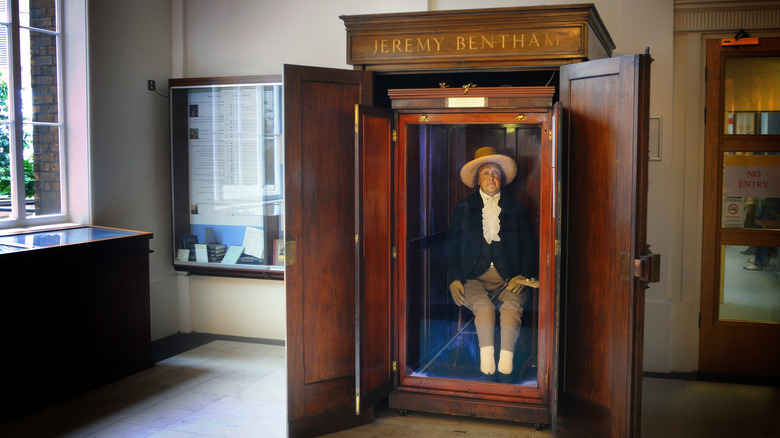The Bizarre Truth Of The Corpse That Once Guarded Its Own Severed Head
Jeremy Bentham was an English economist and philosopher most known for being the founder of modern utilitarianism, the moral theory that advocates for actions that promote happiness for the majority of people. According to University College London, Bentham, born in 1748, was a child prodigy who started learning Latin at 3 years old. By the age of 12, he was already attending Queen's College Oxford to study law. He was an activist who fought for a number of causes including animal rights, liberty for homosexuals, abolition of slavery, and women's rights, to name a few, and he was ahead of his time when it came to his way of thinking.
Apart from being a genius, Bentham was also described as being eccentric. He had two walking sticks named Dobbin and Dapple, a cat named The Reverend Sir John Langbourne who loved eating macaroni, and a teapot that he called Dickey that no one was allowed to touch (via Canadian Broadcasting Corporation). He was also responsible for a number of neologisms, including the words "maximize" and "minimize," as well as "quisquilious," "nooscopic," and hundreds more. Friends said he would often wake up at 6 a.m. and spend two hours "circumgyrating" as he called it (that's jogging to you). Perhaps the most bizarre thing about Bentham was his will, in which he detailed what he wanted to be done to his body after his death.
Jeremy Bentham's last will
Jeremy Bentham died June 6, 1832, at 84 years old, but according to Hyperallergic, he started drafting his will when he was only 21. He stated that he wanted his body to go to his friend, Dr. Thomas Southwood Smith, and he requested to be clothed in one of the suits he usually wore. This information alone seems like a typical request for the preparation of a burial, but upon further reading, Bentham's will becomes more bizarre.
Bentham wanted Dr. Smith to dissect his corpse publicly and then have his body cleaned and padded, much like a human taxidermy project (via Atlas Obscura). His body was to be placed on a chair in a sitting position and was to be encased in a box where his friends and followers can view him during gatherings to commemorate "the founder of the greatest happiness system of morals;" he called it the "Auto-Icon."
Dr. Smith followed his friend's instructions but the embalming process wasn't successful, and Bentham's head ended up looking leathery and quite horrific for display. As a result, Dr. Smith commissioned a wax head of Bentham that was more appropriate for public viewing, per the Canadian Broadcasting Corporation.
The Auto-Icon display
Per his request, Jeremy Bentham's body was enclosed in a case and put on display. His skeleton was covered in his clothing and positioned on a chair. Instead of his real head, however, the wax head was used. For a time, the Auto-Icon stayed in Dr. Thomas Southwood Smith's home until it was moved to the University College London in 1850 (per University College London). For a time, Bentham's severed head was displayed for all to see, and it sat in between his feet. Allegedly, some students from another university stole the head but it was later retrieved in exchange for £10, according to the St. Neots Museum. Later on, the severed head was locked in a wooden box for protection.
Today, Bentham's body still remains on display in a transparent case at the University College London's Student Centre. His real head, however, is kept in an undisclosed location at the university for safekeeping. It is believed that Bentham made the bizarre request in his will because he was an atheist and refused to pay the church for his burial. Regardless of the reason, UCL's Philip Schofield says that he thinks Bentham would be elated by the fact that his remains are still on display many years after his death, as he enjoyed being the center of attention.


